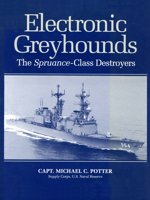


Electronic Greyhounds by Capt. Michael C. Potter.
All 31 “Spru-cans” were built at Litton Ingalls Shipbuilding, Pascagoula, Mississippi. Laid down beginning in 1972 and commissioned between late 1975 and 1980, with Hayler commissioned in 1983, they were the first US Navy ship class powered with gas turbines—four marine versions of jet aircraft engines driving two shafts with reversible-pitch propellers. (Curiously, their screws rotated in the opposite direction from other twin-screw ships.)
Their complement was similar to preceding destroyer classes: 3–400 officers and enlisted personnel. Comfort and habitability were considerations in the ship’s design; some ships were retrofitted to provide separate quarters for female personnel.
Length: 563' 4" overall; 529' waterline.
Beam: 55'.
Draft: 22' hull; 32' navigation.
Displacement: 9,250 long tons full load.
Designed complement: 24 officers; 330 enlisted. (Helicopter detachment: 9 officers; 30 enlisted.)
Propulsion machinery: 4 x LM 2500 General Electric gas turbines; 2 shafts; 80,000 shp.
Speed: 32.5 knots.
Range: 6,000 nm @ 20 knots.
By 2000, however, the remaining Spruances’ capabilities were duplicated or had counterparts in the 27 Flight I and II Arleigh Burkes by then in commission. With the first Flight IIA Burkes soon to complete, despite costing $1 billion or more each, the Burkes were so versatile and cost-effective that the Spruances were completely phased out before the end of their design lifetimes. The last one, Cushing, decommissioned in 2005.
Sources: Friedman, Military Analysis Network, Potter, Destroyer History Foundation database.